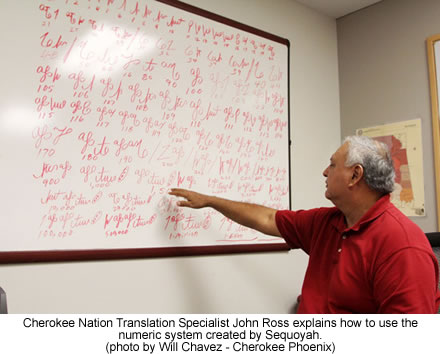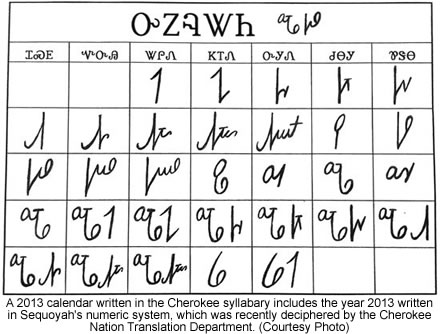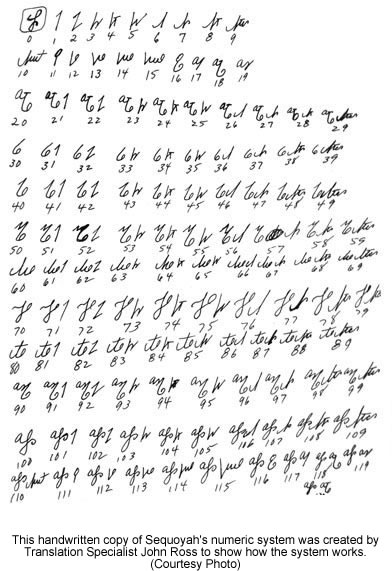 |
Canku Ota
|
 |
|
(Many Paths)
|
||
|
An Online Newsletter
Celebrating Native America
|
||
|
February
2013 - Volume 11 Number 2
|
||
|
|
||
|
Sequoyah's Numeric
System Makes Comeback
|
||
|
by WILL CHAVEZ - Cherokee
Phoenix senior reporter
|
||
 TAHLEQUAH,
Okla. – A visit by linguist Michael Everson of Dublin, Ireland,
in September set in motion an effort to revisit and study Cherokee
linguist Sequoyah's numeric system. TAHLEQUAH,
Okla. – A visit by linguist Michael Everson of Dublin, Ireland,
in September set in motion an effort to revisit and study Cherokee
linguist Sequoyah's numeric system.
During his visit, Everson met with Cherokee linguists and other language specialists to discuss making a font for Sequoyah's numeric system for printing and computers, Cherokee Nation Translation Specialist John Ross said. Everson told Ross and other translators that a system would
have to be created before a font could be made. Following Everson's
visit, Ross studied Sequoyah's numeric system and figured it out
in less than two days. Like he did when matching sounds spoken in the Cherokee language with symbols, Sequoyah created unique, single symbols for numbers 1 through 19 and numbers 20, 30, 40, 50, 60, 70, 80, 90 and 100. So to create the number 31 the symbol for 30 and 1 would be used together. To create the number 500 the symbol for 5 and 100 would be used together. Ross created a symbol for 0 and for 1 billion and 1 trillion. Sequoyah's system enabled users to create numerals up to 1 million.
"They thought it was pretty neat," Ross said. Ross said the only reason he found as to why Sequoyah's numeric system, created in 1830 in Indian Territory, was never used by the tribe is that some people thought the system was too complicated. "Really, if you look at it, it's a shortcut. You don't have to add all those numbers for a million. Like for a billion, you just have those (three) symbols instead of all those zeros," he said. CN Language Technologist Joseph Erb said he believes because Cherokees were already trading with the French, Spanish and British when the system was invented, Arabic numbers were used instead of Sequoyah's system. The way that Cherokees count is how Sequoyah built his system, Erb said. "So, it makes more sense in Cherokee. It's a neat system, it's a very Cherokee system, and it's really nice the translation team made sure to figure out how it works," he said. Sequoyah's numbers have been added to the 2013 Cherokee calendar. Another use for the numeric system would be to teach it to the Cherokee Language Immersion School students, Ross said. Ultimately, the goal for Erb and the language technology staff is to turn the numeric system into fonts, a "slow process," Erb said, possibly taking two years before the system appears on smart phones and computer systems.
Unicode enables people around the world to use computers in any language. The Cherokee numeric system would have to be turned into a code that computers could read and analyze so the proper Cherokee font for 12, for instance, is displayed. After that is done, the coded language must go before the international Unicode Consortium for approval. If the consortium approves the code, it's up to computer companies to adopt the new code, Erb said. The tribe worked with Everson in the 1990s to put the Cherokee syllabary into code, which was adopted by the Unicode Consortium in 2000. His main area of expertise is with world writing systems, specifically in the representation of these systems in formats for computer and digital media. "Only few people know how to do this type of work. It's a very specialty type of work. Michael has done several hundred languages," Erb said. "For us in language technology, it's pretty exciting to see us reintroduce a numbering system, and it will be easy to use. Our goal is to make it accessible to everybody."
|
|
|
||
|
|
||
| Canku Ota is a free Newsletter celebrating Native America, its traditions and accomplishments . We do not provide subscriber or visitor names to anyone. Some articles presented in Canku Ota may contain copyright material. We have received appropriate permissions for republishing any articles. Material appearing here is distributed without profit or monetary gain to those who have expressed an interest. This is in accordance with Title 17 U.S.C. Section 107. | ||
|
Canku Ota is a copyright ©
2000 - 2013 of Vicki Williams Barry and Paul Barry.
|
||
 |
 |
|
|
The "Canku
Ota - A Newsletter Celebrating Native America" web site and
its design is the
|
||
|
Copyright ©
1999 - 2013 of Paul C. Barry.
|
||
|
All Rights Reserved.
|
||
 The
Cherokee Language Consortium, comprised of Cherokee speakers from
the CN, Eastern Band of Cherokee Indians and the United Keetoowah
Band, agreed in October to use Sequoyah's numeric system as he wrote
it and to add the symbols Ross created.
The
Cherokee Language Consortium, comprised of Cherokee speakers from
the CN, Eastern Band of Cherokee Indians and the United Keetoowah
Band, agreed in October to use Sequoyah's numeric system as he wrote
it and to add the symbols Ross created.  "It
(numeric system) has to be in the Unicode system, so what will have
to happen is we'll have to figure out how the numbering system works,
and then we'll have to have a paper written for it to be encoded
into the Unicode system," he said.
"It
(numeric system) has to be in the Unicode system, so what will have
to happen is we'll have to figure out how the numbering system works,
and then we'll have to have a paper written for it to be encoded
into the Unicode system," he said.